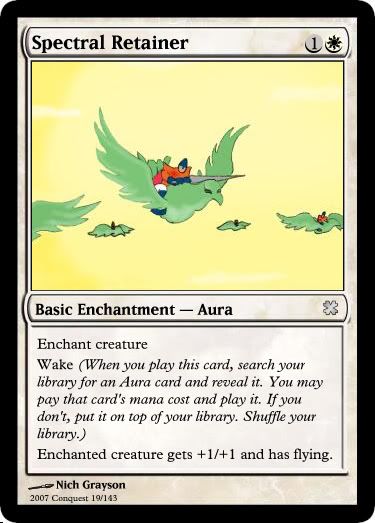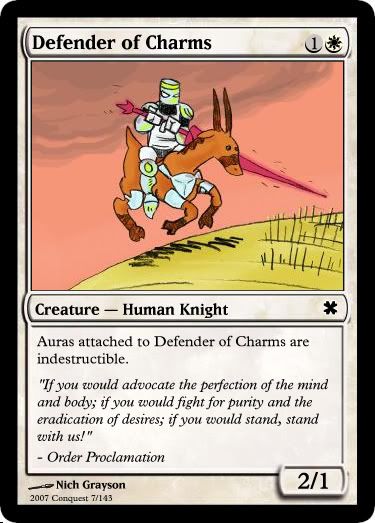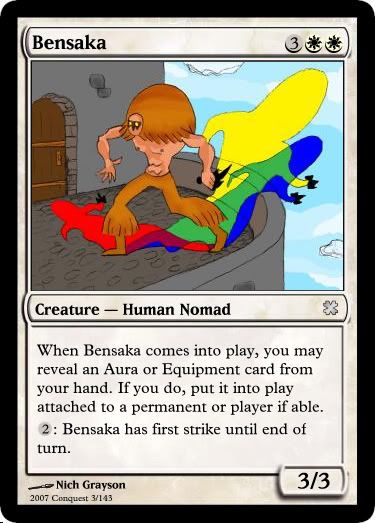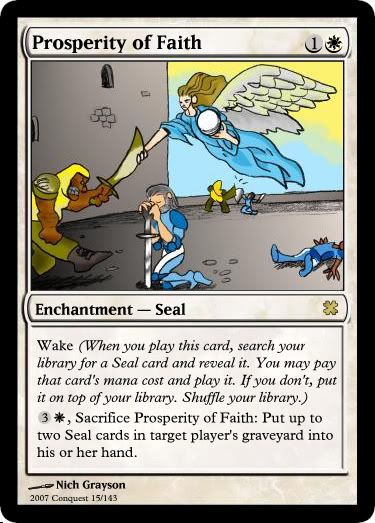
A World of Enchantment
4/6/7
BACK NEXT

Enchantments are sort of lopsided. When unfettered they can be extremely powerful because only three out of five of the colors can do something about one that's in play. On the other hand, when they are Auras and must attach to something in order to be used, they are very weak and those two colors that normally can't stop them become the best at doing so. This is an intrinsic quality of enchantments, a tension in design that I was determined to retain as I focused on them in Conquest. So I had to choose a color partner that could showcase both kinds of enchantments. I narrowed down to white because of this. White is a rules setting color, so it could have unfettered enchantments that set rules. It's also a very strong creature color, and could have Auras based on that dynamic. Plus, because enchantments have barely been explored in the past, white of all the colors seems able to stretch to allow for my new ideas. I need the player to buy into these color partners so they are comfortable when I do weird things.
I'm sort of happy I did choose white, because it was while I was working on Auras that I came up with a major new mechanic of the set. It's called Wake, and it lets you play multiple spells at once. Say what?
Wake is a keyword that you will find on every card type, not just Auras. When you play a card with wake it lets you look for a card that shares its subtype and play it right away. As the Basic Enchantment of the set, Spectral Retainer offers a lot of tutoring for Aura based decks. I think the potential advantage helps take the sting out of removal. If you play Spectral Retainer and in response your opponent destroys the creature you were playing it on, you can still play the second card targeting something else. Or, if they counter the Spectral Retainer, you don’t have to put the second spell in your graveyard.

But back to enchantments. It would have been very easy to just reduce the mana cost of Auras. Or add cantrip effects to them. But I wanted to do some different things. One of the things I tried to do was make destroying their host a bad deal. Or making them poor target choices. Avenging Shepherd, which I am not previewing before the set comes out, has an ability that makes targeting it a bad deal for your opponent while at the same time making it a great host for an Aura.

Now I understand that no protection will be fool proof and Auras still present potential card disadvantage, but I believe Conquest makes a real attempt to reduce that risk. And the results will be fun to play. Wake presents a good means to play multiple enchantments at once, but what if you don't want to pay for them? Bensaka here represents an honest attempt to make up for all the years of spells and abilities that let you play creatures or artifacts on the cheap. It was never time for enchantments, and I tried my best to rectify that.
(Just so you know, if the activated ability seems tacked on or random, there are a number of creatures in the set with activated abilities. It seems less random when you see the whole set, I promise.)
Another idea I employed was a higher number of enchant player Auras. In order to keep my tension, and give black and red a shot, many of the enchant player Auras in Conquest require you to maintain certain conditions. The way they were originally designed, enchant player Auras were rules friendly. They helped make complex interactions simple and provided contextualization for cards that might never have been made. By making them more fragile, I've made them a lot more like other Auras and I think opened a whole new design space.
One of the easiest ways to explore a card type is to give it a new subtype and that's why I created the Seal enchantment type. Seals are enchantments that have abilities with a sacrifice cost to use. And like their previous incarnations, they cross into all colors. By giving this type of enchantment its own name you become free to depart from the original versions and try something new as long as you hold onto the sacrifice element. It's not a typical Seal for the set, but Prosperity of Faith is a pretty good example of where you can start to go with the design of Seals.

Prosperity of Faith also brings up another point that influenced my design decisions. I think enchantments are tied to combo style decks by virtue of how they work, so it shouldn’t be surprising that Combo will get a nice boost from this set. It not something I shied away from when designing Conquest. However, making combos expensive or situational or require a lot of pieces is part of the equation.
Next week, we’ll continue with a preview of the creature color, as well as my favorite Conquest mechanic. Why don’t you spend the weekend working on the Orb of Insight results?